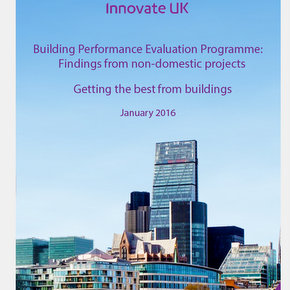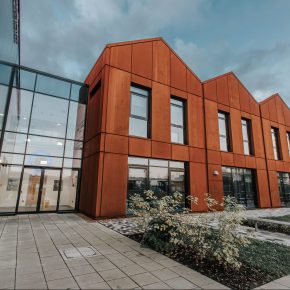
UK buildings carbon emissions scandal
 Howard Chapman, Buildingtalk Editor on the latest carbon reduction reports that show alarming discrepancies between projected savings and actual results.
Howard Chapman, Buildingtalk Editor on the latest carbon reduction reports that show alarming discrepancies between projected savings and actual results.
Data from Innovate UK’s Building Performance Evaluation Programme was analysed for new Goverment reports that demonstrate UK buildings emit far more carbon than they were designed to.
Many modern domestic and commercial buildings are falling short of performance expectations and this undermines UK plans to reduce greenhouse gases by 80% by 2050.
- buildings were routinely using up to 3.5 times more energy than their design had allowed for
- only one of the 48 buildings studied produced the amount of carbon specified by its design.
- total emissions were sometimes 10 times the rate calculated for Part L compliance
The Building Performance Evaluation Programme on ‘actual’ carbon reduction show alarming discrepancies between projected savings and actual results.
It advises constructors on strategies to ensure modern, low-carbon domestic buildings meet expectations after findings that many do not.
Links to download reports:
Domestic Buildings – recommendations
- Handover is a critical opportunity to explain to residents how to operate their homes in different seasons – and outline any maintenance they might need.
- Prepare clear instructions, and leave a simple summary for householders to refer to afterwards.
- Do not assume that actual carbon emissions have any link to estimates of emissions needed for planning consents (also used in Energy Performance Certificates).
- Do not rely on Building Regulations alone to limit energy use and carbon emissions from new buildings.
- Biomass heating and heat pumps are no guarantee of low-carbon emissions.
Non-Domestic Buildings – recommendations
- Put simplicity first – especially when it comes to controls
- Do not substitute systems and controls for lower-cost alternatives if they are harder to use – and potentially unmanageable.
- For Passive House projects, find contractors experienced in meeting Passive House standards.
- Ensure all operatives understand the importance of airtightness, and how to avoid puncturing an air barrier.
- Allow extra time in the programme for innovative systems. Installation often takes longer than expected, and full commissioning before handover is essential.
- Ensure individual installers have previously and successfully installed the systems you are using in similar contexts.
Making reality match design
These report recommendations are a useful starting point if we are to narrow the gap between theoretical savings and real savings in carbon emmissions.
Latest news

13th March 2025
Vent-Axia Publishes Free eBook to Help Social Housing Landlords Navigate Awaab’s Law
Leading British ventilation manufacturer Vent-Axia has published a free eBook, ‘Ensuring Safe Housing Conditions: Focusing on Mould and Damp Conditions’.
Posted in Air Conditioning, Articles, Building Industry News, Building Products & Structures, Building Regulations & Accreditations, Building Services, Damp & Waterproofing, Facility Management & Building Services, Health & Safety, Heating, Ventilation and Air Conditioning - HVAC, Innovations & New Products, Publications, Research & Materials Testing, Retrofit & Renovation
13th March 2025
First Processing Industries apprenticeship completed within West Fraser
West Fraser is pleased to announce that the company’s continued investment in apprenticeships, as well as wider staff development training, has seen one recruit successfully complete his modern apprenticeship.
Posted in Articles, Building Industry Events, Building Industry News, Building Products & Structures, Building Regulations & Accreditations, Building Systems, Recruitment, Restoration & Refurbishment, Retrofit & Renovation, Timber Buildings and Timber Products, Training, Walls, Wooden products
11th March 2025
ADSA’s 40 Years of Innovation
The Automatic Door Suppliers Association (ADSA) is kicking off its 40th anniversary with the launch of an animated timeline that showcases its incredible journey and industry-defining achievements.
Posted in Access Control & Door Entry Systems, Architectural Ironmongery, Articles, Building Associations & Institutes, Building Industry Events, Building Industry News, Building Products & Structures, Building Services, Doors, Facility Management & Building Services, Health & Safety, Innovations & New Products, Recruitment, Retrofit & Renovation, Security and Fire Protection, Training, Videos
11th March 2025
Senior answers the call at Merseyside’s new state-of-the-art fire station
Safe, secure, and sustainable aluminium fenestration solutions from Senior Architectural Systems have been installed at Merseyside Fire & Rescue Service’s brand-new fire station in Aintree.
Posted in Aluminium Products, Articles, Building Industry News, Building Products & Structures, Building Systems, Case Studies, Curtain Walling, Doors, Facades, Glass, Glazing, Restoration & Refurbishment, Retrofit & Renovation, Sustainability & Energy Efficiency, Walls, Windows
 Sign up:
Sign up: 